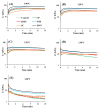The Potential of Soluble Proteins in High-Moisture Soy Protein-Gluten Extrudates Preparation
- PMID: 38139938
- PMCID: PMC10748057
- DOI: 10.3390/polym15244686
The Potential of Soluble Proteins in High-Moisture Soy Protein-Gluten Extrudates Preparation
Abstract
In this study, the effects of different soluble proteins, including collagen peptides (CP), soy protein hydrolysate (HSPI), whey protein isolate (WPI), sodium caseinate (SC), and egg white protein (EWP), on the structural and mechanical properties of blends containing soy protein isolate (SPI) and wheat gluten (WG) were investigated using high-moisture extrusion. The addition of CP and HSPI resulted in a more pronounced fibrous structure with increased voids, attributing to their plasticizing effect that enhanced polymer chain mobility and reduced viscosity. WPI, SC, and EWP acted as crosslinking agents, causing early crosslink formation and decreased polymer chain mobility. These structural variations directly influenced the tensile properties of the extrudates, with CP displaying the highest anisotropic index. Moreover, the presence of soluble proteins impacts the permeability of the extrudates. These insights shed light on how soluble proteins can be used to modify the properties of SPI-WG blends, making them suitable for meat analogue production.
Keywords: SPI-WG blends; anisotropic index; high-moisture extrusion; permeability; rheological properties; soluble proteins.
Conflict of interest statement
The authors declare no conflict of interest.
Figures









References
-
- Zhang Y., Brouwer R., Sala G., Scholten E., Stieger M. Exploring relationships between juiciness perception, food and bolus properties of plant-based meat analogue and beef patties. Food Hydrocoll. 2024;147:109443. doi: 10.1016/j.foodhyd.2023.109443. - DOI
-
- Zhang J., Chen Q., Kaplan D.L., Wang Q. High-moisture extruded protein fiber formation toward plant-based meat substitutes applications: Science, technology, and prospect. Trends Food Sci. Technol. 2022;128:202–216. doi: 10.1016/j.tifs.2022.08.008. - DOI
-
- Pietsch V.L., Bühler J.M., Karbstein H.P., Emin M.A. High moisture extrusion of soy protein concentrate: Influence of thermomechanical treatment on protein-protein interactions and rheological properties. J. Food Eng. 2019;251:11–18. doi: 10.1016/j.jfoodeng.2019.01.001. - DOI
Grants and funding
LinkOut - more resources
Full Text Sources
Miscellaneous

